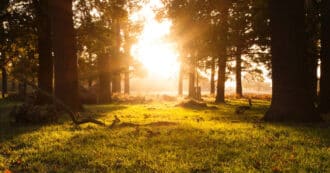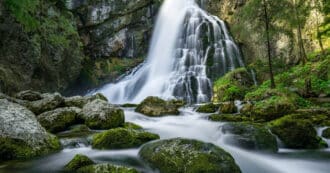The Rev. Dr. Leah D. Schade; leahschade@gmail.com
EcoPreacher 1-2-3 sermon helps for preaching Genesis 2:18-24 using a green lens.
Genesis 2:18-24 is one of the readings for the Nineteenth Sunday after Pentecost in Year A of Revised Common Lectionary, October 5, 2025. This is a Sunday closest to the feast day of St. Francis of Assisi (Oct. 4) and is often celebrated in churches with a “Blessing of the Animals.” This Sunday also marks the end of the Season of Creation which began on Sept. 1.
Focus on Genesis 2:19
So out of the ground the Lord God formed every animal of the field and every bird of the air, and brought them to the man to see what he would call them; and whatever the man called every living creature, that was its name.
Eco-Exegesis
Eco-exegesis is a method of interpreting the biblical text through a green lens using the principles of ecological theology. For this passage, we turn to the Eco Bible, a Jewish ecological commentary on the Hebrew texts.
According to the Eco Bible, “God created animals after people in the second creation story, with the purpose of Adam naming the animals. Adam was engaged in a relationship of recognition and non-violent interaction.”i The story implies that Adam studied each animal not as a commodity to be bought, sold, consumed, or used for himself. Rather, he regarded each of God’s creatures as a sacred nefesh chaya, “soul of life.”
As we envision God leading this procession of animals to Adam, we might see this as the first worship service in Eden! We can imagine Adam gathered with the rest of his Earth-kin in a chorus of whinnies, chortles, buzzes, chitters, and bellows of praise to their Creator.
The Eco Bible goes on to explain that “the original human was granted dominion because of his ability to respect and learn about the animal kingdom in this manner.”ii Rabbi David Seidenberg writes that in the midrashim (interpretive writings) about the relationship between humans and animals in Genesis, rabbis consistently asserted that “the animals come to us as teachers.” In contrast to a hierarchical, utilitarian view of animals, Scripture shows us that “they are not just presented as vassals or objects to be taken care of. We can learn from them only by humbly standing in relation to them, i.e., by ‘under-standing,’ in the truest and deepest sense of the word.”iii
1. Eco-Idea
The Eco-Idea is one succinct statement that tells us who God is and/or what God does in relation to Creation and how we should respond as people of faith. The Eco-Idea for this sermon is:
God created all living creatures as kin to humans and fellow worshipers within the sanctuary of Earth. As such, humans must reorient their attitudes and economies so that animals are treated with respect and honor instead of as products, servants, and entertainment.
2. Eco-Questions
Eco-Questions are what we can ask to help a congregation draw out the implications of the Eco-Exegesis and Eco-Idea.
- On this Sunday when many churches celebrate “Blessing of the Animals,” can we take a hard look at the way we overvalue some animals (such as our pets) and commodify, consume, ignore, or sacrifice others? What are ways that we can shift our attitudes toward animals so that we protect their dwindling and endangered habitats, refrain from abusing them, and, if we must eat them, ensure their humane treatment during their brief lives?
- In a 2017 survey I conducted about U.S. preachers and topics they address in sermons, “species extinction” ranked dead last among subjects clergy talked about in their preaching in the previous year.iv If we envision animals as our fellow worshipers in this Earthly realm, what are ways we can speak for them in our pulpits, congregations, denominations, and interfaith organizations?
3. Eco-Actions
Eco-Actions are ways that a congregation might respond to the Eco-Idea and Eco-Questions. One of these possibilities may have salience for your preaching context.
- Do an Internet search to find out what species of animals are endangered in your area. Invite a local naturalist to talk with your congregation about what your church can do to help protect them. Take up a special collection and make a donation to a local organization committed to preserving this species.
- In its article, “Secrets of the Whales,” National Geographic features the work of marine biologists who have studied whales over the last few decades.v They have learned that different groups of whales have their own dialects and diets and that they share their songs with each other across oceans. In short, whales may have developed culture – once thought to be unique to humans. Talk with your adult and youth learners about how we might better understand ourselves and other species God has made by “standing-under” and learning from them through education and science.
- Start a project called “Our Fellow Worshipers in God’s Creation” to photo-document the creatures that live around the church. Create posters to display in the church and a page on the church’s website that features members’ photos and list the common name as well as scientific name of the animals as well as interesting facts about them.
i. Eco Bible Volume 1: An Ecological Commentary on Genesis and Exodus. Rabbi Yonatan Neril & Rabbi Leo Dee, editors. (Interfaith Center for Sustainable Development, 2020), 13. https://interfaithsustain.com/ecobible/
ii. Ibid, 14.
iii. Rabbi David Seidenberg, “Crossing the Threshold: God’s Image in the More-Than-Human World,” PhD thesis, Jewish Theological Seminary, 2004, 164. Quoted in Eco Bible Volume 1, p. 14.
iv. “Preaching About Controversial Issues.” Unpublished research conducted by Leah D. Schade, 2017. Of the 838 respondents, only 3.5% said they had intentionally or specifically addressed or incorporated the topic of “species extinction” into their preaching in the previous year.
v. Craig Welch, “Secrets of the Whales,” National Geographic. May 2021, 40-79. https://www.amazon.com/National-Geographic-Magazine-Secrets-Whales/dp/B0935L2XGJ
*Featured image source





